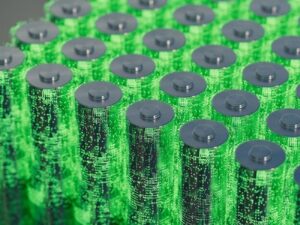Researchers from Rensselaer Polytechnic Institute in the United States have developed a special class of materials for bulky calcium ions, providing pathways for their facile insertion into battery electrodes.

Image: RPI
Against a backdrop of soaring prices and predicted shortfalls of lithium-ion battery materials, the search for inexpensive, abundant, safe, and sustainable battery chemistries has never been more critical. Calcium has been considered in batteries, but the larger size and higher charge density of its ions, relative to lithium, have posed challenges for their insertion into electrode materials.
Now, researchers from Rensselaer Polytechnic Institute in the United States have reported progress in addressing this issue and unlocking the potential of high-performing calcium-ion batteries.
“The calcium ion is divalent, and hence one ion insertion will deliver two electrons per ion during battery operation,” said Nikhil Koratkar, the John A. Clark and Edward T. Crossan Professor of Engineering at Rensselaer. “This allows for a highly efficient battery with reduced mass and volume of calcium ions.”
However, the larger size and higher charge density of calcium ions relative to lithium impairs diffusion kinetics and cyclic stability, he added. The team has overcome this problem by developing oxide structures containing big open spaces (heptagonal and hexagonal channels). In their work, an aqueous calcium-ion battery is demonstrated using orthorhombic and trigonal polymorphs of molybdenum vanadium oxide (MoVO) as a host for calcium ions.
The researchers have demonstrated that calcium ions can be rapidly inserted and extracted from the material, with these tunnels acting as “conduits” for reversible and fast ion transport. The findings indicate that MoVO provides one of the best performances reported to date for the storage of calcium ions.
Specifically, for trigonal MoVO, a specific capacity of ∼203 mAh g−1 was obtained at 0.2C and at a 100 times faster rate of 20C, an ∼60 mAh g−1 capacity was achieved. The open-tunnel trigonal and orthorhombic polymorphs also promoted cyclic stability and reversibility. These findings were recently published in Proceedings of the National Academy of Sciences (PNAS).
“Calcium-ion batteries might one day, in the not-so-distant future, replace lithium-ion technology as the battery chemistry of choice that powers our society,” says Koratkar. “This work can lead of a new class of high-performing calcium-based batteries that use earth abundant and safe materials and are therefore affordable and sustainable. Such batteries could find widespread use in portable and consumer electronics, electric vehicles, as well as grid and renewable energy storage.”
Author: Marija Maisch for PV Magazine


